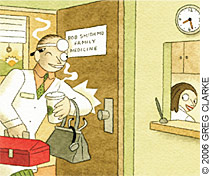
FPM’s online toolbox equips you with more than 150 practice management tools.
Fam Pract Manag. 2006;13(8):56

In any given week, the typical family physician spends 51 hours in practice – 40 hours in direct patient care, diagnosing and treating nearly 100 patients, and 11 hours in meetings and performing administrative tasks.1 Managing your patients, your staff, your practice and your time is no small feat.
To help, Family Practice Management has developed a collection of more than 150 practice management tools over the years. Stored in our online toolbox (https://www.aafp.org/fpm/toolbox), these checklists, coding resources, encounter forms, reminder letters and more are always just a few mouse clicks away. Whether you use them as is or to inspire your own solutions, they can help bring order to difficult aspects of your practice.
10 toolbox highlights
Here’s a small sampling of the tools you’ll find in the FPM Toolbox.
Level-IV worksheet. This worksheet helps physicians quickly assess whether a patient encounter qualifies as a level-IV visit.
Today’s visit checklist. This brief form can be filled out by patients in the waiting room and helps uncover their goals and expectations for the current visit. It also helps prevent “Oh, by the way” issues from surfacing as the visit is about to end.
Diabetes registry. Created in Microsoft Excel, this registry can help practices track whether their patients who have diabetes are up-to-date on needed services and whether their clinical measures are within acceptable targets. Spreadsheet cells are programmed to automatically turn red to indicate that action is needed.
Outpatient anticoagulation flow sheet. This flow sheet tracks patients’ warfarin doses and includes a dosage adjustment algorithm and anticoagulation decision support.
Medication use agreement. Patients being prescribed drugs for chronic pain can sign this form to signal their agreement not to misuse the drugs.
Medicare opt-out notice and private contract with Medicare beneficiary. These forms can be used by physicians to opt out of the program and enter into private contracts with Medicare patients.
Health plan comparison spreadsheet. This tool enables a practice to compare its health plans’ performance based on key financial and service indicators.
Job satisfaction survey. This rating sheet helps practices evaluate their performance in the area of staff satisfaction and identify where improvement is needed.
EHR cost/benefit worksheet. This worksheet helps physicians estimate the costs and savings associated with implementing an electronic health record system.
Interview questions. This resource lists the essential questions to ask when hiring physicians, nurses, support staff and administrators.
Adding to the toolbox
FPM is always looking to add tools that have the potential to improve family physicians’ practices. If you have an idea for a tool you’d like to see, or if you have a tool you’d like to share, e-mail us at fpmedit@aafp.org.